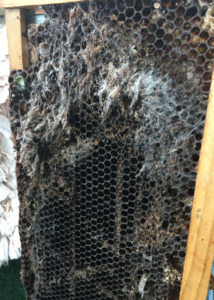
A strong hive is the best defense against wax moths. One preventive action is to not give the bees more territory than they can guard. In other words, don’t leave a lot of drawn comb on a hive that is small and struggling.
Wax moth traps can help keep the wax moth population under control (but also will capture other bees, wasps, and flying insects).
Bacillus thuringienis, subsp. Aizawazi. is one of the most effective biological controls available for wax moth control. Two products are currently available: Certan in Canada or XenTari in the US. XenTari is labeled for use against moth larvae (but not wax moth per se). This kills the larva of the wax moth.

XenTari is a dry flowable powder and is available from Amazon. This is mixed with water and sprayed on the woodenware of the hives. The wax moths contact the BT which infects their larva and breaks the breeding cycle. BT seems to have no ill effects on the bees and studies have supported this view. Since learning about BT from my friend Eugene, I’ve used it for all frames going into the hives and all frames (with drawn comb) that I’m storing (I don’t spray the areas of comb that may still have pollen in them).
Two tablespoons of powder can treat 100 to 110 frames. BT may be used to protect stored comb as well, but spraying comb filled with pollen does not work well. Freezing used comb is an effective way to keep wax moths from destroying stored comb.
Another method for protecting stored comb is to use Paradichlorobenzene (PDB) moth crystals in storage. PDB is considered a carcinogen so not for all beekeepers.